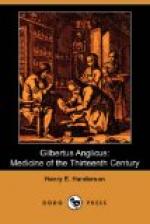And again, in his discussion of the treatment of gout and rheumatism (f. 327b), Gilbert adds, under the title
Emperica
“Quamvis ego declino ad has res parum, tamen est bonum scribere in libro nostro, ut non remaneat tractatus sine eis quas dixrunt antiqui. Dico igitur quod dixit torror: Si scinderis pedem rane viridis et ligaveris supra pendem podagrici per tres dies, curatur; ita quod dextrum pedum rane ponas supra dextrum pedem patientis, et e converso. Et dixit Funcius, qui composuit librum de lapidibus, quod magnes, si ligatus fuerit in pedem podagrici, curatur. Et alius philosophus dixit. Si accipiatur calcancus asine et ponatur ligatus supra pedem egri, curatur, ita quod dexter supra dextrum, et e converso. Et juravit quod sit verum. Et dixit torror quod si ponatur pes testudinis dexter supra dextrum pedem podagrici, et e converso, curatur.”
We may believe, indeed, that Gilbert would have preferred to follow in the therapeutic footsteps of Hippocrates, had he not disliked to be regarded by his colleagues as eccentric and opinionated. For he says in his treatment of thoracic diseases (f. 193c):
“Etenim eleganter dedit Ipo. (Hippocrates) modum curationis, sed ne a medicis nostri temporis videamur dissidere, secundum eos curam assignemus.”
Gilbert was a scholastic-humoralistic physician par excellence, delighting in superfine distinctions and hair-splitting definitions, and deriving even pediculi from a superfluity of the humors (f. 81d). Of course he was also a polypharmacist, and the complexity, ingenuity, and comprehensiveness of his prescriptions would put to shame even the “accomplished therapeutist” of these modern days. In dietetics too Gilbert was careful and intelligent, and upon this branch of therapeutics he justly laid great emphasis.
The first book of the Compendium, comprising no less than 75 folios, is devoted entirely to the discussion of fevers. Beginning with the definition of Joannicius (Honain ebn Ishak):
“Fever is a heat unnatural and surpassing the course of nature, proceeding from the heart into the arteries and injuring the patient by its effects.”
Gilbert launches out with genuine scholastic finesse and verbosity into a discussion of the questions whether this definition is based upon the essentia or the differentia of fever; whether the heat of fever is natural or unnatural, and other similar subtle speculations, and finally arrives at a classification of fevers so elaborate and complex as to be practically almost unintelligible to the modern reader.
The more important of these fevers or febrile conditions are:
Ephemeral
Hemitertian
Double quartan
Interpolated
Synocha
Causon synochides
Epilala
Quotidian
Double tertian
Quintan
Continued
Causon
Putrid
Lipparia
Tertian
Quartan
Sextan
Synochus
Synochus causonides
Ethica
Erratica




